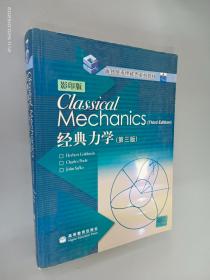
经典力学:第3版
¥ 40 6.0折 ¥ 66.4 九品
仅1件
北京海淀
认证卖家担保交易快速发货售后保障
作者Goldstein 著;HERBERT、GOLDSTEIN、CHARLES、POOLE、JOHN SAFKO 译
出版社高等教育出版社
出版时间2005-02
版次1
装帧平装
货号9-5
上书时间2024-08-29
- 最新上架
商品详情
- 品相描述:九品
图书标准信息
- 作者 Goldstein 著;HERBERT、GOLDSTEIN、CHARLES、POOLE、JOHN SAFKO 译
- 出版社 高等教育出版社
- 出版时间 2005-02
- 版次 1
- ISBN 9787040160918
- 定价 66.40元
- 装帧 平装
- 开本 16开
- 纸张 胶版纸
- 页数 638页
- 字数 850千字
- 正文语种 英语
- 【内容简介】
- 美国哥伦比亚州大学Herbert Goldstein编著的《经典力学》(Classical Mechanics)是一本有着很高知名度的经典力学教材,长期以来被世界上多所大学选用。本影印版是2002年出版的第3版。与前两版相比,第3版在保留基本经典力学内容的基础上,做了不少调整。例如,增加了混沌一章;引入了一些对新研究问题的方法的讨论,例如张量、群论的等;对于第二版中的一些内容做了适当的压缩和调整 全书共13章,可作为为物理类专业经典力学课程的教材,尤其适合开展双语教学的学校,对于有志出国深造的人员也是一本必不可少的参考书。
- 【目录】
-
1 Survey of the Elementary Principles
1.1 Mechanics of a Particle 1
1.2 Mechanics of a System of Particles 5
1.3 Constraints 12
1.4 D'Alembert's Principle and Lagrange's Equations 16
1.5 Velocity-Dependent Potentials and the Dissipation Function 22
1.6 Simple Applications of the Lagrangian Formulation 24
2 Variational Principles and I.agrange's Equations
2.1 Hamilton's Principle 34
2.2 Some Techniques of the Calculus of Variations 36
2.3 Derivation of Lagrange's Equations from Hamilton's Principle 44
2.4 Extension of Hamilton's Principle to Nonholonomic Systems 45
2.5 Advantages of a Variational Principle Formulation 51
2.6 Conservation Theorems and Symmetry Properties 54
2.7 Energy Function and the Conservation of Energy 60
3 The Central Force Problem
3.1 Reduction to the Equivalent One-Body Problem 70
3.2 The Equations of Motion and First Integrals 72
3.3 The Equivalent One-Dimensional Problem, and
Classification of Orbits 76
3.4 The Virial Theorem 83
3.5 The Differential Equation for the Orbit, and Integrable
Power-Law Potentials 86
3.6 Conditions for Closed Orbits (Bertrand's Theorem) 89
3.7 The Kepler Problem: Inverse-Square Law of Force 92
3.8 The Motion in Time in the Kepler Problem 98
3.9 The Laplace-Runge-Lenz Vector 102
3.10 Scattering in a Central Force Field 106
3.11 Transformation of the Scattering Problem to Laboratory
Coordinates 114
3.12 The Three-Body Problem 121
4 The Kinematics of Rigid Body Motion
4.1 The Independent Coordinates of a Rigid Body 134
4.2 Orthogonal Transformations 139
4.3 Formal Properties of the Transformation Matrix 144
4.4 The Euler Angles 150
4.5 The Cayley-Klein Parameters and Related Quantities 154
4.6 Euler's Theorem on the Motion of a Rigid Body 155
4.7 Finite Rotations 161
4.8 Infinitesimal Rotations 163
4.9 Rate of Change of a Vector 171
4.10 The Coriolis Effect 174
5 The Rigid Body Equations of Motion
5.1 Angular Momentum and Kinetic Energy of Motion
about a Point 184
5.2 Tensors 188
5.3 The Inertia Tensor and the Moment of Inertia 191
5.4 The Eigenvalues of the Inertia Tensor and the Principal
Axis Transformation 195
5.5 Solving Rigid Body Problems and the Euler Equations of
Motion 198
5.6 Torque-free Motion of a Rigid Body 200
5.7 The Heavy Symmetrical Top with One Point Fixed 208
5.8 Precession of the Equinoxes and of Satellite Orbits 223
5.9 Precession of Systems of Charges in a Magnetic Field 230
6 Oscillations
6.1 Formulation of the Problem 238
6.2 The Eigenvalue Equation and the Principal Axis Transformation 241
6.3 Frequencies of Free Vibration, and Normal Coordinates 250
6.4 Free Vibrations of a Linear Triatomic Molecule 253
6.5 Forced Vibrations and the Effect of Dissipative Forces 259
6.6 Beyond Small Oscillations: The Damped Driven Pendulum and the
Josephson Junction 265
7 The Classical Mechanics of the
Special Theory of Relativity
7.1 Basic Postulates of the Special Theory 277
7.2 Lorentz Transformations 280
7.3 Velocity Addition and Thomas Precession 282
7.4 Vectors and the Metric Tensor 286
7.5 1-Forms and Tensors 289
7.6 Forces in the Special Theory; Electromagnetism 297
7.7 Relativistic Kinematics of Collisions and Many-Particle
Systems 300
7.8 Relativistic Angular Momentum 309
7.9 The Lagrangian Formulation of Relativistic Mechanics 312
7.10 Covariant Lagrangian Formulations 318
7.11 Introduction to the General Theory of Relativity 324
8 The Hamilton Equations of Motion
8.1 Legendre Transformations and the Hamilton Equations
of Motion 334
8.2 Cyclic Coordinates and Conservation Theorems 343
8.3 Routh's Procedure 347
8.4 The Hamiltonian Formulation of Relativistic Mechanics 349
8.5 Derivation of Hamilton's Equations from a
Variational Principle 353
8.6 The Principle of Least Action 356
9 Canonical Transformations
9.1 The Equations of Canonical Transformation 368
9.2 Examples of Canonical Transformations 375
9.3 The Harmonic Oscillator 377
9.4 The Symplectic Approach to Canonical Transformations 381
9.5 Poisson Brackets and Other Canonical Invariants 388
9.6 Equations of Motion, Infinitesimal Canonical Transformations, and
Conservation Theorems in the Poisson Bracket Formulation 396
9.7 The Angular Momentum Poisson Bracket Relations 408
9.8 Symmetry Groups of Mechanical Systems 412
9.9 Liouville's Theorem 419
10 Hamilton-lacobi Theory and Action-Angle Variables
10.1 The Hamilton-Jacobi Equation for Hamilton's Principal
Function 430
10.2 The Harmonic Oscillator Problem as an Example of the
Hamilton-Jacobi Method 434
10.3 The Hamilton-Jacobi Equation for Hamilton's Characteristic
Function 440
10.4 Separation of Variables in the Hamilton-Jacobi Equation 444
10.5 Ignorable Coordinates and the Kepler Problem 445
10.6 Action-angle Variables in Systems of One Degree of Freedom 452
10.7 Action-Angle Variables for Completely Separable Systems 457
10.8 The Kepler Problem in Action-angle Variables 466
11 Classical Chaos
11.1 Periodic Motion 484
11.2 Perturbations and the Kolmogorov-Arnold-Moser Theorem 487
11.3 Attractors 489
11.4 Chaotic Trajectories and Liapunov Exponents 491
11.5 Poincar6 Maps 494
11.6 Hrnon-Heiles Hamiltonian 496
11.7 Bifurcations, Driven-damped Harmonic Oscillator, and Parametric
Resonance 505
11.8 The Logistic Equation 509
11.9 Fractals and Dimensionality 516
12 Canonical Perturbation Theory
12.1 Introduction 526
12.2 Time-dependent Perturbation Theory 527
12.3 Illustrations of Time-dependent Perturbation Theory 533
12.4 Time-independent Perturbation Theory 541
12.5 Adiabatic Invariants 549
13 Introduction to the Lagrangian and HamUtonian
Formulations for Continuous Systems and Fields
13.1 The Transition from a Discrete to a Continuous System 558
13.2 The Lagrangian Formulation for Continuous Systems 561
13.3 The Stress-energy Tensor and Conservation Theorems 566
13.4 Hamiltonian Formulation 572
13.5 Relativistic Field Theory 577
13.6 Examples of Relativistic Field Theories 583
13.7 Noether's Theorem 589
Appendix A Euler Angles in Alternate Conventions and Cayley-Klein Parameters
Appendix B Groups and Algebras
Selected Bibliography
Author Index
Subject Index
点击展开
点击收起
相关推荐
— 没有更多了 —


























以下为对购买帮助不大的评价